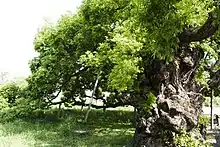| Salix pierotii | |
|---|---|
 | |
| Here given as Salix koreensis | |
| Scientific classification | |
| Kingdom: | Plantae |
| Clade: | Tracheophytes |
| Clade: | Angiosperms |
| Clade: | Eudicots |
| Clade: | Rosids |
| Order: | Malpighiales |
| Family: | Salicaceae |
| Genus: | Salix |
| Species: | S. pierotii |
| Binomial name | |
| Salix pierotii | |
| Synonyms[2] | |
|
List
| |
Salix pierotii, the Korean willow, is a species of willow native to northeast China, far eastern Russia, the Korean peninsula and Japan.[2] They are shrubs or trees reaching 8 m. Because their twisted wood is not good for timber or making tools, in Japan Salix pierotii trees are used to demarcate property lines between farms.[3]
Forms
One form is currently accepted:[2]
- Salix pierotii f. auricomans Kimura
References
- ↑ Ann. Mus. Bot. Lugduno-Batavi 3: 27 (1867)
- 1 2 3 "Salix pierotii Miq". Plants of the World Online. Board of Trustees of the Royal Botanic Gardens, Kew. 2017. Retrieved 8 September 2020.
- ↑ Tokuoka, Yoshinori; Yamasaki, Fukuhiro; Kimura, Kenichiro; Hashigoe, Kiyokazu; Oka, Mitsunori (2019). "Tracing chronological shifts in farmland demarcation trees in southwestern Japan: Implications from species distribution patterns, folk nomenclature, and multiple usage". Journal of Ethnobiology and Ethnomedicine. 15. doi:10.1186/s13002-019-0301-8. PMC 6487015. PMID 31029161. S2CID 139104568.
This article is issued from Wikipedia. The text is licensed under Creative Commons - Attribution - Sharealike. Additional terms may apply for the media files.